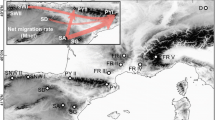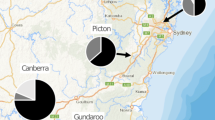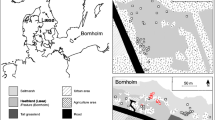Abstract
The California seed harvester ant Pogonomyrmex californicus exhibits striking differences in queen behavior and colony organization throughout its range. Most populations show the likely ancestral condition of single-queen colonies (monogyny). However, in one known population, cooperation between queens during colony founding (pleometrosis) occurs, and is suspected to persist to the mature colony stage (primary polygyny). To better understand this variation in social phenotype, we estimate relatedness among co-foundresses, measure the frequency of polygyny in adult colonies across three focal populations, and assess population genetic structure between populations. We additionally measure queen mating frequency (polyandry) across focal populations. With few possible exceptions, queens within pleometrotic associations are unrelated. We demonstrate a correlation between pleometrosis in incipient colonies and polygyny in adult colonies at the population level. Nuclear microsatellites and mtDNA barcoding indicate significant structure between focal populations. Queens from all three focal populations engage in relatively high levels of polyandry. These findings, when examined with previous data demonstrating that pleometrosis leads to polygynous colonies in the laboratory, strongly suggest that the same occurs in nature. However, the possibility of additional queen adoption in adult colonies (secondary polygyny) is not excluded. Thus, polygynous P. californicus colonies potentially represent long-term associations of unrelated family groups, containing multiple unrelated queens and their mixed-paternity offspring. Due to its pronounced variation in social behavior, P. californicus provides a unique opportunity to examine the evolutionary history and genetic underpinnings of cooperation among non-relatives, a strategy of intense interest in behavioral ecology.





Similar content being viewed by others
References
Alonso WJ, Schuck-Paim C (2002) Sex-ratio conflicts, kin selection, and the evolution of altruism. Proc Natl Acad Sci USA 99:6843. doi:10.1073/pnas.092584299
Aviles L (2002) Solving the freeloaders paradox: genetic associations and frequency-dependent selection in the evolution of cooperation among nonrelatives. Proc Natl Acad Sci USA 99:14268–14273. doi:10.1073/pnas.212408299
Baglione V, Canestrari D, Marcos JM, Ekman J (2003) Kin selection in cooperative alliances of carrion crows. Science 300:1947. doi:10.1126/science.1082429
Balshine-Earn S, Neat FC, Reid H, Taborsky M (1998) Paying to stay or paying to breed? Field evidence for direct benefits of helping behavior in a cooperatively breeding fish. Behav Ecol 9:432–438. doi:10.1093/beheco/9.5.432
Bartz SH, Hölldobler B (1982) Colony founding in Myrmecocystus mimicus Wheeler (Hymenoptera, Formicidae) and the evolution of foundress-associations. Behav Ecol Sociobiol 10:137–147. doi:10.1007/BF00300174
Bekkevold D, Frydenberg J, Boomsma JJ (1999) Multiple mating and facultative polygyny in the Panamanian leafcutter ant Acromyrmex echinatior. Behav Ecol Sociobiol 46:103–109. doi:10.1007/s002650050598
Bernasconi G, Keller L (1996) Reproductive conflicts in cooperative associations of fire ant queens (Solenopsis invicta). Proc R Soc Lond B Biol Sci 263:509–513. doi:10.1098/rspb.1996.0077
Bernasconi G, Strassmann JE (1999) Cooperation among unrelated individuals: the ant foundress case. Trends Ecol Evol 14:477–482. doi:10.1016/S0169-5347(99)01722-X
Bourke AFG (1988) Dominance orders, worker reproduction, and queen-worker conflict in the slave-making ant Harpagoxenus sublaevis. Behav Ecol Sociobiol 23:323–333. doi:10.1007/bf00300579
Bourke AFG, Franks NR (1995) Social evolution in ants. Princeton University Press, Princeton
Bourke AFG, Green HA, Bruford MW (1997) Parentage, reproductive skew and queen turnover in a multiple-queen ant analysed with microsatellites. Proc R Soc Lond B Biol Sci 264:277. doi:10.1098/rspb.1997.0039
Bshary R (2010) Cooperation between unrelated individuals—a game theoretic approach. Animal behaviour: evolution and mechanisms. Springer, Berlin, pp 213–240
Buckley SB (1867) Descriptions of new species of North American Formicidae. Entomol Soc Phila 6:335–350
Cahan S (1999) Causes and consequences of an abrupt transition in colony founding behavior in the ant Messor pergandei - Ph.D. dissertation, Arizona State University, Tempe
Cahan SH (2001) Ecological variation across a transition in colony-founding behavior in the ant Messor pergandei. Oecologia 129:629–635. doi:10.1007/s004420100761
Cahan SH, Fewell JH (2004) Division of labor and the evolution of task sharing in queen associations of the harvester ant Pogonomyrmex californicus. Behav Ecol Sociobiol 56:9–17. doi:10.1007/s00265-003-0746-5
Cahan S, Helms KR, Rissing SW (1998) An abrupt transition in colony founding behaviour in the ant Messor pergandei. Anim Behav 55:1583–1594. doi:10.1006/anbe.1997.0699
Chapuisat M (1998) Mating frequency of ant queens with alternative dispersal strategies, as revealed by microsatellite analysis of sperm. Mol Ecol 7:1097–1105. doi:10.1046/j.1365-294x.1998.00422.x
Cheney DL, Moscovice LR, Heesen M et al (2010) Contingent cooperation between wild female baboons. Proc Natl Acad Sci USA 107:9562–9566. doi:10.1073/pnas.1001862107
Clark RM, Fewell JH (2014) Social dynamics drive selection in cooperative associations of ant queens. Behav Ecol 25:117–123. doi:10.1093/beheco/art093
Clutton-Brock T (2002) Breeding together: kin selection and mutualism in cooperative vertebrates. Science 296:69. doi:10.1126/science.296.5565.69
Clutton-Brock T (2009) Cooperation between non-kin in animal societies. Nature 462:51–57. doi:10.1038/nature08366
Cole BJ (2009) The ecological setting of social evolution: the demography of ant populations. In: Gadau J, Fewell J (eds) Organization of insect societies: from genome to sociocomplexity. Harvard University Press, Cambridge, p 74–104
Cole BJ, Wiernasz DC (2000) The nature of ant colony success—response. Science 287:1363. doi:10.1126/science.287.5457.1363b
Core Team R (2014) R: a language and environment for statistical computing. R Foundation for Statistical Computing, Vienna
Creel SR, Rabenold KN (1994) Inclusive fitness and reproductive strategies in dwarf mongooses. Behav Ecol 5:339–348. doi:10.1093/beheco/5.3.339
Diehl E, de Araújo AM, Cavalli-Molina S (2001) Genetic variability and social structure of colonies in Acromyrmex heyeri and A. striatus (Hymenoptera: Formicidae). Braz J Biol 61:667–678. doi:10.1590/S1519-69842001000400017
Dolezal AG, Brent CS, Gadau J et al (2009) Endocrine physiology of the division of labour in Pogonomyrmex californicus founding queens. Anim Behav 77:1005–1010. doi:10.1016/j.anbehav.2009.01.010
Dugatkin LA (2002) Animal cooperation among unrelated individuals. Naturwissenschaften 89:533–541. doi:10.1007/s00114-002-0379-y
Dugatkin LA, Mesterton-Gibbons M (1996) Cooperation among unrelated individuals: reciprocal altruism, by-product mutualism and group selection in fishes. Biosystems 37:19–30. doi:10.1016/0303-2647(95)01542-6
Evanno G, Regnaut S, Goudet J (2005) Detecting the number of clusters of individuals using the software STRUCTURE: a simulation study. Mol Ecol 14:2611–2620. doi:10.1111/j.1365-294X.2005.02553.x
Fomer O, Black M, Hoeh W et al (1994) DNA primers for amplification of mitochondrial cytochrome c oxidase subunit I from diverse metazoan invertebrates. Mol Mar Biol Biotechnol 3:294–299
Foster RL, Brunskill A, Verdirame D, O’Donnell S (2004) Reproductive physiology, dominance interactions, and division of labour among bumble bee workers. Physiol Entomol 29:327–334. doi:10.1111/j.0307-6962.2004.00388.x
Gadau J (2009) DNA isolation from ants. Cold Spring Harb Protoc 2009(7). doi:10.1101/pdb.prot5245
Gadau J, Strehl CP, Oettler J, Hölldobler B (2003) Determinants of intracolonial relatedness in Pogonomyrmex rugosus (Hymenoptera; Formicidae): mating frequency and brood raids. Mol Ecol 12:1931–1938. doi:10.1046/j.1365-294X.2003.01853.x
Goudet J (1995) FSTAT (version 1.2): a computer program to calculate F-statistics. J Hered 86:485
Griffin AS, West SA (2003) Kin discrimination and the benefit of helping in cooperatively breeding vertebrates. Science 302:634. doi:10.1126/science.1089402
Hacker M, Kaib M, Bagine RKN et al (2005) Unrelated queens coexist in colonies of the termite Macrotermes michaelseni. Mol Ecol 14:1527–1532. doi:10.1111/j.1365-294X.2005.02507.x
Hamilton WD (1964) The genetical evolution of social behaviour. I. J Theor Biol 7:1–16. doi:10.1016/0022-5193(64)90038-4
Hamilton WD (1971) Selection of selfish and altruistic behaviour in some extreme models. Man and beast: comparative social behavior. Smithsonian Press, Washington, D.C., pp 57–91
Hammond R, Bourke A, Bruford M (2001) Mating frequency and mating system of the polygynous ant, Leptothorax acervorum. Mol Ecol 10:2719–2728. doi:10.1046/j.0962-1083.2001.01394.x
Heinze J (1993) Queen-queen interactions in polygynous ants. Queen number and sociality in insects. Oxford University Press, Oxford, pp 334–361
Helms KR, Helms Cahan S (2012) Large-scale regional variation in cooperation and conflict among queens of the desert ant Messor pergandei. Anim Behav 84:499–507. doi:10.1016/j.anbehav.2012.05.019
Holbrook CT, Eriksson TH, Overson RP et al (2013) Colony-size effects on task organization in the harvester ant Pogonomyrmex californicus. Insectes Soc 60:191–201. doi:10.1007/s00040-013-0282-x
Hölldobler B, Carlin NF (1985) Colony founding, queen dominance and oligogyny in the Australian meat ant Iridomyrmex purpureus. Behav Ecol Sociobiol 18:45–58. doi:10.1007/BF00299237
Hölldobler B, Wilson E (2009) The superorganism: the beauty, elegance, and strangeness of insect societies. WW Norton & Company Inc, New York
Hölldobler B, Grillenberger B, Gadau J (2011) Queen number and raiding behavior in the ant genus Myrmecocystus (Hymenoptera: Formicidae). Myrmecol News 15:53–61
Hughes AR, Inouye BD, Johnson MTJ et al (2008) Ecological consequences of genetic diversity. Ecol Lett 11:609–623. doi:10.1111/j.1461-0248.2008.01179.x
Hunt J (2007) The evolution of social wasps. Oxford University Press, New York
Ito F (1993) Social organization in a primitive ponerine ant: queenless reproduction, dominance hierarchy and functional polygyny in Amblyopone sp. (reclinata group) (Hymenoptera: Formicidae: Ponerinae). J Nat Hist 27:1315–1324. doi:10.1080/00222939300770751
Jeanson R, Fewell J (2008) Influence of the social context on division of labor in ant foundress associations. Behav Ecol 19:567. doi:10.1093/beheco/arn018
Johnson RA (2004) Colony founding by pleometrosis in the semiclaustral seed-harvester ant Pogonomyrmex californicus (Hymenoptera: Formicidae). Anim Behav 68:1189–1200
Johnson RA, Overson RP (2009) A new North American species of Pogonomyrmex (Hymenoptera: Formicidae) from the Mohave Desert of eastern California and western Nevada. J Hymenopt Res 18:305–314
Johnson RA, Overson RP, Moreau CS (2013) A new species of seed-harvester ant, Pogonomyrmex hoelldobleri (Hymenoptera: Formicidae), from the Mohave and Sonoran Deserts of North America. Zootaxa 3646:201–227. doi:10.11646/zootaxa.3646.3.1
Keller L (1995) Social life: the paradox of multiple-queen colonies. Trends Ecol Evol 10:355–360. doi:10.1016/S0169-5347(00)89133-8
Keller L, Reeve HK (1994) Genetic variability, queen number, and polyandry in social Hymenoptera. Evolution 48:694–704. doi:10.2307/2410479
Kellner K, Trindl A, Heinze J, D’Ettorre P (2007) Polygyny and polyandry in small ant societies. Mol Ecol 16:2363–2369. doi:10.1111/j.1365-294X.2007.03297.x
Kolmer K, Heinze J (2000) Rank orders and division of labour among unrelated cofounding ant queens. Proc R Soc Lond B Biol Sci 267:1729–1734. doi:10.1098/rspb.2000.1202
Kolmer K, Hölldobler B, Heinze J (2002) Colony and population structure in Pachycondyla cf. inversa, a ponerine ant with primary polygyny. Ethol Ecol Evol 14:157–164. doi:10.1080/08927014.2002.9522754
Kronauer DJ, Boomsma JJ (2007) Multiple queens means fewer mates. Curr Biol 17:R753–R755. doi:10.1016/j.cub.2007.06.057
Kronauer DJC, Johnson RA, Boomsma JJ (2007) The evolution of multiple mating in army ants. Evolution 61:413–422. doi:10.1111/j.1558-5646.2007.00040.x
Mintzer AC (1987) Primary polygyny in the ant Atta texana: number and weight of females and colony foundation success in the laboratory. Insectes Soc 34:108–117. doi:10.1007/BF02223829
Monnin T, Peeters C (1999) Dominance hierarchy and reproductive conflicts among subordinates in a monogynous queenless ant. Behav Ecol 10:323–332. doi:10.1093/beheco/10.3.323
Nielsen R, Tarpy DR, Reeve HK (2003) Estimating effective paternity number in social insects and the effective number of alleles in a population. Mol Ecol 12:3157–3164. doi:10.1046/j.1365-294X.2003.01994.x
Overson R, Gadau J, Clark RM et al (2013) Behavioral transitions with the evolution of cooperative nest founding by harvester ant queens. Behav Ecol Sociobiol. doi:10.1007/s00265-013-1618-2
Pamilo P (1993) Polyandry and allele frequency differences between the sexes in the ant Formica aquilonia. Heredity 70:472–480. doi:10.1038/hdy.1993.69
Pedersen JS, Boomsma JJ (1999a) Positive association of queen number and queen-mating frequency in Myrmica ants: a challenge to the genetic-variability hypotheses. Behav Ecol Sociobiol 45:185–193. doi:10.1007/s002650050552
Pedersen JS, Boomsma JJ (1999b) Multiple paternity in social Hymenoptera: estimating the effective mate number in single–double mating populations. Mol Ecol 8:577–587. doi:10.1046/j.1365-294x.1999.00573.x
Penick CA, Liebig J, Brent CS (2011) Reproduction, dominance, and caste: endocrine profiles of queens and workers of the ant Harpegnathos saltator. J Comp Physiol A 197:1063–1071. doi:10.1007/s00359-011-0667-0
Pew J, Wang J, Muir P, Frasier T (2015) related: related: an R package for analyzing pairwise relatedness data based on codominant molecular markers. R package version 1.0
Pol R, de Casenave J, Feldhaar H et al (2008) Polyandry in two South American harvester ants. Insectes Soc 55:91–97. doi:10.1007/s00040-007-0975-0
Pritchard J, Stephens M, Donnelly P (2000) Inference of population structure using multilocus genotype data. Genetics 155:945
Qian ZQ, Schlüns H, Schlick-Steiner BC et al (2011) Intraspecific support for the polygyny-vs.-polyandry hypothesis in the bulldog ant Myrmecia brevinoda. Mol Ecol 20:3681–3691. doi:10.1111/j.1365-294X.2011.05195.x
Queller D, Goodnight K (1989) Estimating relatedness using genetic markers. Evolution 43:258–275. doi:10.2307/2409206
Queller DC, Strassmann JE (1998) Kin selection and social insects. Bioscience 48:165–175. doi:10.2307/1313262
Queller DC, Zacchi F, Cervo R et al (2000) Unrelated helpers in a social insect. Nature 405:784–787. doi:10.1038/35015552
Rheindt FE, Gadau J, Strehl CP, Hölldobler B (2004) Extremely high mating frequency in the Florida harvester ant (Pogonomyrmex badius). Behav Ecol Sociobiol 56:472–481. doi:10.1007/s00265-004-0808-3
Rissing SW, Pollock GB (1987) Queen aggression, pleometrotic advantage and brood raiding in the ant Veromessor pergandei (Hymenoptera, Formicidae). Anim Behav 35:975–981. doi:10.1016/S0003-3472(87)80154-9
Rissing SW, Pollock GB, Higgins MR et al (1989) Foraging specialization without relatedness or dominance among co-founding ant queens. Nature 338:420–422. doi:10.1038/338420a0
Rissing SW, Johnson RA, Martin JW (2000) Colony founding behavior of some desert ants: geographic variation in metrosis. Psyche (Stuttg) 103:95
Röseler P-F, Röseler I, Strambi A, Augier R (1984) Influence of insect hormones on the establishment of dominance hierarchies among foundresses of the paper wasp, Polistes gallicus. Behav Ecol Sociobiol 15:133–142. doi:10.1007/BF00299381
Schlüns E, Wegener B, Schlüns H et al (2009) Breeding system, colony and population structure in the weaver ant Oecophylla smaragdina. Mol Ecol 18:156–167. doi:10.1111/j.1365-294X.2008.04020.x
Sefc KM, Koblmüller S (2009) Assessing parent numbers from offspring genotypes: the importance of marker polymorphism. J Hered 100:197–205. doi:10.1093/jhered/esn095
Sommer K, Hölldobler B (1995) Colony founding by queen association and determinants of reduction in queen number in the ant Lasius niger. Anim Behav 50:287–294. doi:10.1006/anbe.1995.0244
Starr CK (1984) Sperm competition, kinship, and sociality in the aculeate Hymenoptera. In: Smith RL (ed) Sperm competition and the evolution of animal mating systems. Academic Press, Inc., Orlando, pp 427–464
Tamura K, Dudley J, Nei M, Kumar S (2007) MEGA4: molecular evolutionary genetics analysis (MEGA) software version 4.0. Mol Biol Evol 24:1596. doi:10.1093/molbev/msm092
Toquenaga Y (2005) Special feature: cooperation among unrelated individuals—Preface. Popul Ecol 47:1–2. doi:10.1007/s10144-005-0206-3
Trontti K, Thurin N, Sundström L, Aron S (2007) Mating for convenience or genetic diversity? Mating patterns in the polygynous ant Plagiolepis pygmaea. Behav Ecol 18:298–303. doi:10.1093/beheco/arl083
Trunzer B, Heinze J, Hölldobler B (1998) Cooperative colony founding and experimental primary polygyny in the ponerine ant Pachycondyla villosa. Insectes Soc 45:267–276. doi:10.1007/s000400050087
Tschinkel WR, Howard DF (1983) Colony founding by pleometrosis in the fire ant, Solenopsis invicta. Behav Ecol Sociobiol 12:103–113. doi:10.1007/BF00343200
Volny VP, Gordon DM (2002) Characterization of polymorphic microsatellite loci in the red harvester ant, Pogonomyrmex barbatus. Mol Ecol Notes 2:302–303. doi:10.1046/j.1471-8286.2002.00243.x
West-Eberhard MJ (1975) The evolution of social behavior by kin selection. Q Rev Biol 50:1–33. doi:10.1086/408298
Wiernasz D, Perroni C, Cole B (2004) Polyandry and fitness in the western harvester ant, Pogonomyrmex occidentalis. Mol Ecol 13:1601–1606. doi:10.1111/j.1365-294X.2004.02153.x
Wright S (1950) Genetical structure of populations. Nature 166:247–249. doi:10.1038/166247a0
Acknowledgments
We would like to thank Tresa Marchi and Danielle Sensenig, who worked tirelessly and efficiently at genotyping samples. Robert A. Johnson, C. Tate Holbrook, Joshua D. Gibson, and Brendon Mott provided samples. Bert Hölldobler provided valuable contributions to the development of ideas leading to this study. We would also like to thank two anonymous reviewers for their thorough feedback which strongly improved this manuscript.
Author information
Authors and Affiliations
Corresponding author
Electronic supplementary material
Below is the link to the electronic supplementary material.
Rights and permissions
About this article
Cite this article
Overson, R., Fewell, J. & Gadau, J. Distribution and origin of intraspecific social variation in the California harvester ant Pogonomyrmex californicus . Insect. Soc. 63, 531–541 (2016). https://doi.org/10.1007/s00040-016-0497-8
Received:
Revised:
Accepted:
Published:
Issue Date:
DOI: https://doi.org/10.1007/s00040-016-0497-8




